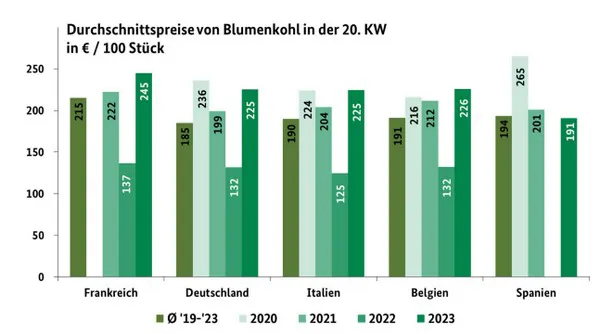French cauliflower imports slowed, but remained at the top of the supply in terms of importance. According to the BLE, the presence of domestic offers expanded. Shipments from Italy, Belgium, Spain and the Netherlands were only of a supplementary nature. Demand was generally not particularly strong and could be satisfied without difficulty.
 © BLE
© BLE
Traders often lowered their prices to improve sales. Berlin reported stable listings which were able to maintain their high level as a result of friendly interest. In Frankfurt prices for Belgian, French and Spanish batches picked up a little towards the weekend. There, however, the domestic and Italian products became cheaper from Thursday.
Apples
Domestic goods prevailed, but overall lost market share to overseas imports. Chilean and New Zealand supplies grew strongly and generally played a larger role than before: from Chile mainly Royal Gala and Elstar, from New Zealand mainly Cox Orange and small quantities of Royal Gala.
Pears
South African deliveries clearly dominated the scene: Packham`s Triumph, Trout and Abate Fetel formed the basis of the range. Forelle and Abate Fetel also came primarily from Chile. Argentina provided mainly Williams Christ. Fruits from Italy, the Netherlands, inland and Turkey had only a supplementary status.
Table grapes
Chilean and South African imports predominated. Relatively small quantities came from India and Peru. After the first Italian Victoria and Black Magic opened the European season last week, Flame Seedless also arrived in the meantime, but they were not fully convincing in terms of quality.
Strawberries
Marketing was mixed: rainy weather, limited customer uptake after Mother's Day and returns from food retailers resulted in sluggish sales. In addition, there were extended deliveries, so that sellers were hardly able to avoid price reductions if they wanted to avoid surpluses. On the other hand, there was also limited supply.
Lemons
Spanish Verna slowly but surely replaced Primofiori of the same origin. In terms of importance, South African Eureka followed. Imports from Zimbabwe, Greece, Italy and Turkey had only a complementary character.
Bananas
Demand was not particularly strong and was met without difficulty. Meanwhile, the ripeners had sufficiently adjusted the supply to the limited sales. Consequently, distributors were mostly able to maintain their previous prices.
Lettuces
In iceberg lettuce, a switch from Spanish to domestic supplies was in the offing: Spanish products increasingly suffered from quality weaknesses and domestic products massively expanded their presence. German batches were in the lead in colorful salads, followed by Belgian batches.
Cucumbers
Belgian, Dutch and domestic products formed the basis of the offer, Spanish ones completed it with low volumes. Demand was nice, but deliveries were so large that distributors were unable to increase their demands. As a result of reduced input prices, prices on the square even fell again in some places.
Tomatoes
Vine tomatoes predominated and came primarily from the Netherlands and Belgium. Turkish imports were apparently limited. Round tomatoes were primarily provided by Belgium and Turkey. Dutch and Italian fruit led the way in cherry tomatoes.
Sweet peppers
As a result of reduced availability, prices for Dutch and Belgian goods climbed. Turkish imports often became cheaper or showed a wide price range due to quality and volume. Spanish inflows completed the product range, as did domestic batches.
Asparagus
The dominant domestic lots were flanked by a few European deliveries, all of which were of a supplementary nature. The focus of the range was clearly on domestic offerings. Marketing was initially very quiet, and a certain degree of customer saturation could not be denied after Mother's Day.
Source: BLE
